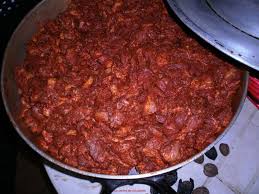The pig slaughter is a regular number one method of slaughter, or pigs, in order to take advantage of his flesh, and elaborate inlays. These sausages are consumed for a year for a family.
This practice is rooted in many European countries. Once a year it takes place during the coldest winter months (usually December). It usually has a festive and celebratory hand, has an economic side.
Preparation.
Arriving in March (spring in the Iberian Peninsula) and the negotiation begins in livestock markets for the purchase of one or more pigs (gilts) for slaughter, to be sacrificed in the month of December. Thus, fattening always started 9 or 10 months before slaughter. The fattening pig was carefully planned, so that was fed to pigs with specific foods: cabbage, pumpkins, potatoes, beets, corncobs, thistles, nettles, wheat flour, rye flour, cereal, apples, pears, quinces, etc. In rural areas, it was common for landlords calculate the number of pigs they need to feed their serfs during the harvest period, depending on the amount of land cultivated, since the pork was the main ingredient of the broth they were given as maintenance.
The fattening.
In Extremadura, and other regions where the meadows, with oak trees, fattening abound is the last phase of pig breeding. This occurs when pigs are left free in the pasture, coinciding with the ripening and falling acorn, in the months of October, November and December. The fattening on acorns, grass and herbs of the meadow and the physical strain of animal, under liberalization, get their meat has a unique taste.
Ranching in the northern regions of Spain was characterized by:
- A strict immobilization of the animal (This is no longer made) in tiny pigsties, of which it is made out to the pig once a day to take a walk around the farm, when the farmers took the opportunity to clean the pigsty .
- A select different vegetables and diet food, for taking the pig out the appropriate weight of about 15 pounds (200 kg).
The days before slaughter.
The days before slaughter family meetings were held, usually inviting one or two neighbors and knives were prepared. Then the elders of the family chose a day to do the slaughter, a day that was anticipated without rain, fog, snow or humidity (ideal was a sunny day with a good morning frost).
The slaughter.
The day of the massacre have breakfast an hour or two before dawn. A hearty breakfast is usually taken as the day is often hard work. There are people who often accompany breakfast with a glass of brandy.
The session begins has barely left the Sun: between 9 and 10am. The butcher is provided with a hook which engages the jaw pig (the pig is already dead) and takes him to a wooden bench. Next to butcher several women and children with buckets and buckets are positioned to collect the blood and remove pork, preventing curdling. The pig's blood was later used for the production of sausages and pancakes.
Once the animal is bled, proceed to charred, burning the skin of the pig. To do this, it puts the pork on a bed of combustible material (broom, broom, bracken or straw) to remove hair from the skin. Then, with the help of a knife, pig skin is scraped to remove the burnt hair.
Then the pig is opened, and all the viscera are removed carefully keeping them. Part of the viscera, especially the intestines and stomach, are reserved and cleaned of its contents. This operation is performed generally by the women of the family who, all together, they head to the nearest stream and cleaned of all dirt. It is not a pleasant operation since odor, extreme cold and moisture are present during the process.

After this, a sample (from different parts of meat) to the vet in the region is given (usually usually first thing in the morning, the third day of slaughter) and he gives his verdict at noon, if the verdict is positive children, tail pig roast and eat.
In the afternoon we continue with cleaning the viscera and begins to chop the bread, cook the rice and onions to make the sausages. That day, in the evening, a dinner is held on the first pig meat is eaten.
The minced meat is done the day after. In the morning cutting out the parts of the pig is cut up and shared among different "specialists": people who salted hams and pork shoulders; people mince meat, seasoned and added garlic to make chorizo; persons marinating pork loin; people who put salted bacon, etc.
That day, a fire is lit and the first pieces of meat are roasted, seasoned with garlic and paprika, and accompanied by a good young wine.

After eating, the removal of fat from the pork is done. Grease gets into a pot and melt in fire. The liquid fat is left to cool in earthen jars. Part of this fat can be used in soap making.
To embed the sausage special machine is used. This machine, by pressing enter chopped (and seasoned) meat in the gut of the pig.
After smoking occurs. Smoking is a very important operation because it depends on the good condition of the sausage. In this operation the younger people work. Is to put the sausage on a large fire with fire and smoke. The smoked sausage concludes when is dry and suitable for consumption.
